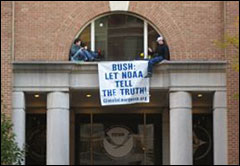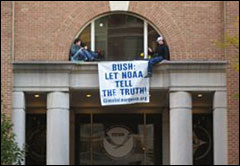On a recent Monday morning, at exactly 8 a.m., a dozen global-warming activists converged in Washington, D.C., at the main entrance to the National Oceanic and Atmospheric Administration.

Will a D.C. protest get the ball rolling?
Photo: climateemergency.org
Two activists dressed as window washers — painter’s hats on, squeegees in hand — carried a 32-foot extension ladder to the building’s main entrance. They ascended the ladder and secured themselves atop a narrow ledge 25 feet above the ground. Within seconds they had unfurled a large banner that read: “Bush: Let NOAA Tell the Truth!”
On the ground, the ladder disappeared while dozens more protesters emerged with placards saying things like “Global Warming = Stronger Hurricanes!” The entrance to a major federal agency, one whose politically appointed leadership has been widely condemned for suppressing scientific climate reports, was effectively occupied.
For the rest of the day, the occupation was major news in the nation’s capital. The main NPR station broadcast hourly live updates of the ensuing standoff with police, repeating the activists’ call for open science and clean energy. A Fox News helicopter hovered overhead, filming everything. And more than 150 newspapers picked up the Associated Press story about this day of principled activism in the face of politicized science.
As director of the U.S. Climate Emergency Council, I was one of the chief organizers of this event and played the role of main negotiator with the dozens of police and Homeland Security officials who eventually arrived to try to coax the activists off the ledge. My motivation for acting was simple. Those of us within the emerging global-warming movement in America routinely use the words “emergency” and “crisis” and “impending catastrophe” to describe — accurately — the runaway heating now afflicting our planet. Wildfires are off the charts. The Greenland ice sheet is imploding. Hurricanes are unrecognizable in their fury. And NASA’s James Hansen says we have less than 10 years to profoundly alter our use of fossil fuels.
“Emergency, crisis, catastrophe,” we say.
But do our actions, as activists and policy advocates, reflect our words? Does our daily work, as fine and passionate as it is, reflect the desperate reality as we see it?
The answer, I submit, is a resounding “no!”
I speak from experience. For the past five years, while gasping at the near-weekly scientific reports of rapid climate demise, I’ve worked almost nonstop promoting profoundly modest clean-energy policies in my region. These include a policy mandating that 7 percent of Maryland’s electricity come from clean sources. I’ve worked on a “clean cars” campaign in D.C. that affects only 0.2 percent of U.S. automobiles. Even these baby steps have come after bruising, intense political battles. And like similar state and regional laws heroically won across the country, the bills in my region are phased in over many years — time we positively don’t have.
The Democrats have retaken Congress, but the best we can probably hope for — thanks to still-lagging public awareness and the diluting influence of Detroit and ExxonMobil — is global-warming legislation that kicks in with any force about the year Hansen says it will already be too late for the planet.
So, by itself, the legislative/policy fight will not — and does not promise to — work in time to solve the “emergency.” What, then, is missing? What more should we be doing to bring our actions in line with the crisis?
The answer, I believe, is to stop using bold adjectives and dramatic language in voices that are routinely calm and polite. The answer is to start shouting passionately at the tops of our lungs. The answer is to shut down the entrances to federal buildings and stage noisy campus sit-ins and peacefully “display” tons of raw coal on the U.S. Capitol lawn.
We need this not because getting locked up is a justified ego trip, allowing us to self-righteously shame America with the TV cameras rolling. We need it because, if done in a spirit of love and justice, it’s our only hope on a terrifyingly tight deadline.
It’s also the only way previous social movements have been made whole and therefore successful. While the NAACP was working the courts, Martin Luther King Jr. was on the street boycotting buses. While anti-Vietnam War legislators were holding hearings in Congress, men and women of service age were putting daisies in rifle barrels. Big change requires both legislative action and determined public protest.
With the climate movement, we have lots of legislative action and almost no feet on the street. It’s one of our biggest problems. Let me be clear: I’m not saying the current battles for small legislative gains in scattered cities, states, and — soon — Congress, should be abandoned. These are vitally important warm-up steps for the sprint just ahead of us. I’m just saying that, with the enormity of the threat at hand and the paucity of time, we’ll never get running fast enough with these steps alone. We’ve got to add this other, time-honored dimension of creative protest to our tool kit of actions right now, and in a major way. There’s simply no way around it.
Which is why several dozen of us worked together to shut down the NOAA entrance for several hours that Monday morning. Our goal, at least for that day, was to draw broader public attention to the suppression of climate science. Our goal was also to say to activists everywhere in the growing grassroots climate movement: “Come on in. The water’s fine. We can and must do this.”
By midday, our protest began drawing to a close. Paul Burman, 23, and Ted Glick, 57 — both bold, nonviolent climate heroes — were taken off the ledge by police in a cherry-picker after frustrating authorities all morning and displaying that banner to millions of people via radio, TV, the internet, and newspapers: “Let NOAA Tell the Truth!”
The men were arrested, charged with three misdemeanors each, and released on their own recognizance. One charge, “reckless endangerment” of themselves and others, seemed particularly misdirected, given that George Bush and his NOAA cronies are recklessly endangering 6.2 billion people with an impending global climate collapse.
But unless a critical mass of us within the climate movement begins shouting out our dissent while sitting down in entrances or standing up in the streets, future generations may level the same charge at us: Despite knowing the truth, despite knowing the danger, they went only halfway, and so the danger came in full and engulfed us.


